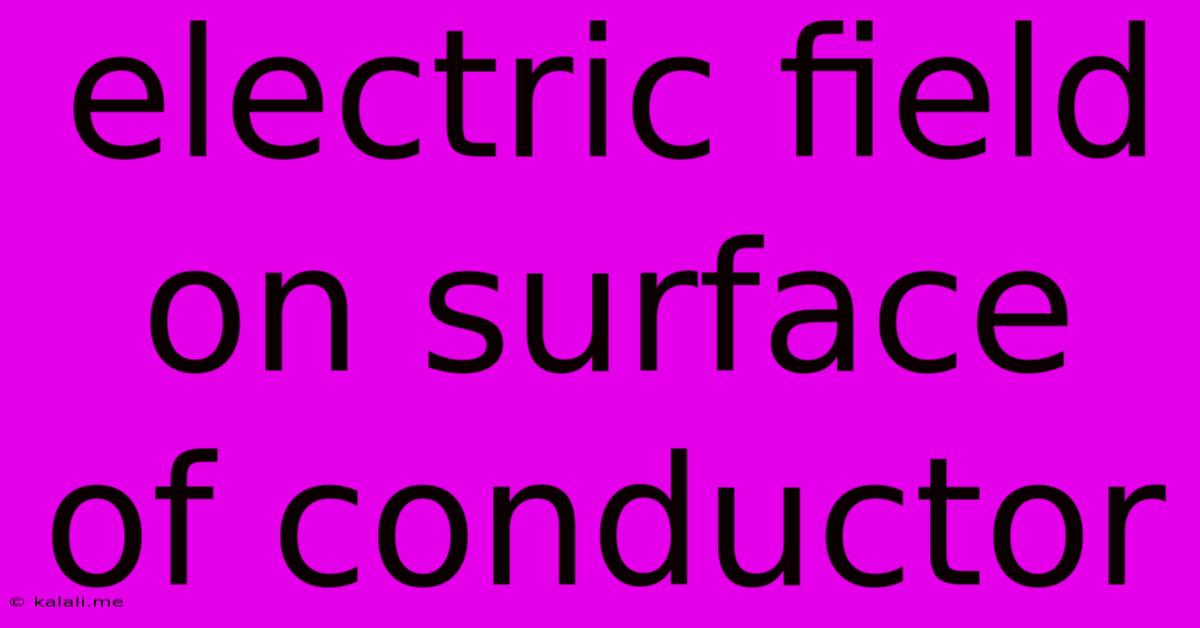Electric Field On Surface Of Conductor
Kalali
Jun 02, 2025 · 4 min read

Table of Contents
Electric Field on the Surface of a Conductor: A Comprehensive Guide
Meta Description: Understand the unique properties of the electric field at the surface of a conductor. This guide explores the concept, its implications, and real-world applications with clear explanations and helpful diagrams.
The behavior of electric fields near the surface of a conductor is a fundamental concept in electromagnetism with significant implications in various applications. This article provides a comprehensive understanding of this phenomenon, explaining its characteristics and exploring its practical uses. We'll delve into the key principles governing the electric field distribution on a conductor's surface and examine some real-world examples.
Understanding Conductors and Electric Fields
Before delving into the specifics of the electric field on a conductor's surface, let's establish a foundation. A conductor is a material that allows electric charge to move freely within it. Metals, such as copper and silver, are excellent conductors due to the presence of loosely bound electrons that can easily migrate throughout the material. An electric field, on the other hand, is a region of space where a charged particle experiences a force. The strength of the electric field is directly proportional to the magnitude of the charge and inversely proportional to the square of the distance from the charge (Coulomb's Law).
The Electric Field Inside a Conductor
A crucial characteristic of conductors in electrostatic equilibrium (no net movement of charges) is that the electric field inside the conductor is always zero. This is because if there were an electric field within the conductor, the free charges would experience a force and move until the field is neutralized. This movement continues until the electric field within the conductor is entirely cancelled out. This equilibrium state ensures that there's no net force on the free charges within the material.
The Electric Field at the Surface of a Conductor
The situation at the surface of the conductor is quite different. The electric field does not abruptly vanish at the surface; instead, it is perpendicular to the surface. This perpendicularity is a direct consequence of the zero electric field inside the conductor. If the electric field had a component parallel to the surface, the free charges would experience a force along the surface, leading to further charge redistribution and contradicting the equilibrium condition. Therefore, to maintain equilibrium, the electric field lines must meet the conductor's surface at a right angle.
Calculating the Electric Field at the Surface
The magnitude of the electric field at the surface of a conductor is directly related to the surface charge density (σ), which represents the amount of charge per unit area on the surface. This relationship is expressed by the equation:
E = σ/ε₀
where:
- E is the electric field strength
- σ is the surface charge density
- ε₀ is the permittivity of free space (a constant)
This equation highlights that a higher surface charge density results in a stronger electric field at the surface.
Applications and Examples
The understanding of electric fields on conductor surfaces has numerous practical applications:
- Capacitors: The operation of capacitors relies heavily on the ability of conductors to store charge, and the electric field between the capacitor plates is a crucial factor in determining their capacitance.
- Lightning Rods: Lightning rods utilize the principle of charge concentration at sharp points to facilitate a safe discharge of atmospheric electricity. The high electric field at the sharp tip of the rod ionizes the surrounding air, providing a path for the lightning strike to the ground.
- Electrostatic Discharge (ESD) Protection: Electronic components are vulnerable to damage from ESD. Understanding the electric field distribution helps in designing protective measures to mitigate ESD risks.
- High Voltage Engineering: The design of high voltage equipment considers the strength of the electric field at the surfaces of conductors to prevent electrical breakdown and arcing.
Conclusion
The electric field on the surface of a conductor is a fundamental concept with widespread implications in various electrical and electronic applications. The fact that the electric field is perpendicular to the surface and its relationship with surface charge density are crucial aspects for understanding the behavior of charges in conductors and designing effective electrical systems. By mastering this concept, engineers and physicists can develop innovative solutions in numerous fields.
Latest Posts
Latest Posts
-
Were Jesus And John The Baptist Cousins
Jun 04, 2025
-
The Penny In The Bucket Saying
Jun 04, 2025
-
Dumbledore At The Base Of The Astronomy Tower
Jun 04, 2025
-
Can You Feed A Baby In A Car Seat
Jun 04, 2025
-
How To Open A Python Interpreter Bash
Jun 04, 2025
Related Post
Thank you for visiting our website which covers about Electric Field On Surface Of Conductor . We hope the information provided has been useful to you. Feel free to contact us if you have any questions or need further assistance. See you next time and don't miss to bookmark.